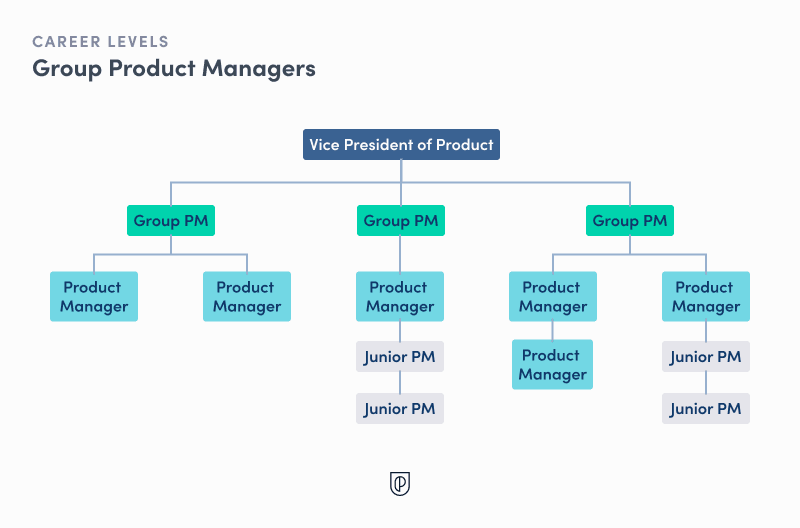Updated: December 4, 2024- 8 min read
Imagine being at the crossroads of innovation and leadership, where your decisions shape not just one, but several products that can transform an industry. Welcome to the world of the Group Product Manager (GPM), one of the senior-level types of product management roles. Unlike a typical Product Manager who focuses on a single product, a GPM orchestrates multiple product lines, ensuring each aligns with the overarching company vision and strategy.
In this article, we’ll explore what sets the GPM role apart, dive into their daily challenges, and outline the pathway to becoming one. Whether you’re aiming to become a GPM or just curious about this crucial role in product-driven companies, you’ll discover valuable insights and guidance here.
Product Roadmapping Micro-Certification (PRC)™️
Product School has partnered with Productboard to create a micro-certification on how to build and maintain effective Roadmaps. Enroll for free to learn how to communicate the product vision and strategy to your stakeholders and customers.
Enroll for Free
What is a Group Product Manager?
Understanding the Group Product Manager Job Description
Group Product Managers (GPMs) are pivotal in defining and executing the strategy for multiple products. They align product goals with business objectives, translate high-level priorities into actionable plans, and oversee the entire product lifecycle from conception to launch. GPMs identify market opportunities, leverage customer insights, and ensure timely delivery of products while balancing short-term needs with long-term goals.
Beyond strategy, GPMs lead and mentor a team of Product Managers, fostering collaboration across engineering, design, and marketing. They serve as the primary communication link between product teams and senior leadership, ensuring clear updates and alignment. GPMs also track key performance indicators (KPIs) to measure success and drive continuous improvement based on data and feedback.
What Does a Group Product Manager Do Daily?
A typical day for a Group Product Manager (GPM) is dynamic and multifaceted, requiring a balance between strategic planning and hands-on management.
Morning Coordination and Team Stand-Ups
GPMs often start their day with team stand-ups or coordination meetings. These sessions are crucial for aligning daily priorities, addressing any roadblocks, and ensuring that all product managers and their teams are synchronized on their tasks and goals.
Strategic Planning and Roadmap Sessions
Throughout the day, GPMs engage in strategic planning and roadmap discussions. These sessions involve setting long-term objectives, prioritizing initiatives, and ensuring that product roadmaps align with business goals. GPMs must balance immediate needs with future opportunities, adjusting plans as necessary based on new insights or changes in the market.
Stakeholder Engagement and Updates
Regular interactions with stakeholders are a key part of the GPM's role. GPMs provide updates to senior leadership, gather feedback, and refine strategies accordingly. This communication ensures that all stakeholders are informed and that product plans are aligned with the broader company strategy.
Reviewing Product Designs and Approvals
GPMs also spend time reviewing product designs, specifications, and development progress. They provide critical feedback, approve key milestones, and ensure that the products meet quality and strategic standards before moving forward.
Analyzing Performance Data and Reporting
Data analysis is another crucial daily task. GPMs analyze key performance indicators (KPIs), customer feedback, and market trends to track product performance and inform decisions. They prepare reports and presentations to communicate insights and product status to teams and leadership.
How to Become a Group Product Manager
Educational Background and Key Skills
To become a Group Product Manager, a solid educational foundation is essential. Most GPMs hold degrees in Business, Engineering, Computer Science, or related fields. Advanced degrees like an MBA can be particularly beneficial, providing a deeper understanding of business strategy and leadership.
However, what sets GPMs apart are the skills they develop: strong leadership to inspire and guide teams, strategic thinking to drive long-term product visions, excellent communication to articulate ideas effectively, and a robust technical know-how to understand the intricacies of product development.
Career Pathway to Group Product Manager
The journey to becoming a GPM typically starts in roles such as Product Manager (PM), Business Analyst, or Engineering Manager. These positions provide hands-on experience in managing products and leading cross-functional teams. Aspiring GPMs should focus on leading significant product initiatives and successfully launching projects to build a proven track record. As they gain experience and demonstrate their ability to manage complex products and guide teams, they can progress to senior positions and eventually step into the role of a Group Product Manager.
Certifications and Learning
Relevant certifications can also play a crucial role in advancing to a GPM role. Programs like the Product Leader Certification from Product School are highly recommended. This certification offers advanced training that’s tailored to senior product managers looking to take their careers to the next level.
Beyond certifications, continuous learning is key. Staying updated with the latest trends in product management, leadership skills, and technological advancements ensures that GPMs remain effective and competitive in their field.
Group Product Manager Roles Compared to Other Product Positions

Understanding how a Group Product Manager (GPM) differs from other product management roles can provide clarity on the unique responsibilities and strategic importance of the GPM position. Here’s a concise look at the key differences between GPMs and other related roles:
Group Product Manager vs. Product Manager
Scope and Responsibility: A Product Manager (PM) typically focuses on a single product or a specific feature. They are deeply involved in the day-to-day management and execution of their product’s roadmap, ensuring it meets user needs and business goals. In contrast, a Group Product Manager (GPM) oversees multiple products or a portfolio of products. They set the strategic direction for several product lines and manage a team of PMs, ensuring all products align with the company’s broader objectives.
Management Level: PMs are more hands-on with individual product development, while GPMs take a broader view, orchestrating the collective efforts of multiple PMs to drive overall product strategy and cohesion.
Group Product Manager vs. Senior Product Manager
Leadership and Scope: A Senior Product Manager (SPM) handles larger, more complex products or a suite of related features. They are involved in higher-level strategic thinking and often shape the product vision and strategy more deeply than a regular PM. However, an SPM still typically focuses on a single product or a closely related group of features.
Broader Leadership: GPMs, on the other hand, take on a broader leadership role. They manage and mentor multiple PMs, ensuring alignment across various products and coordinating their efforts to support the company’s strategic goals. This role requires extensive cross-functional collaboration and a deep understanding of how each product fits into the larger portfolio.
Group Product Manager vs. Director of Product
Strategic Influence: Directors of Product operate at a higher organizational level than GPMs. They are responsible for setting the overarching product strategy for the entire company and often oversee multiple GPMs and PMs.
Focus Areas: While GPMs are more involved in the day-to-day management and execution of product plans within their domain, Directors of Product focus on the broader strategic direction and overall performance of the company’s product portfolio. Directors are more concerned with high-level strategy and organizational alignment.
Group Product Manager vs. VP of Product
Executive Leadership: The Vice President (VP) of Product is a senior executive role, responsible for the entire product organization. VPs set the high-level product vision and strategy for the company and are involved in top-level decision-making and aligning product initiatives with business goals.
Tactical vs. Strategic: While GPMs focus on managing the execution of strategies across multiple products and leading teams of PMs, VPs of Product operate at a strategic level, shaping long-term product vision and driving alignment with the company’s overall business objectives. GPMs are more involved in the tactical aspects of bringing multiple products to market successfully.
Embrace Your Journey to Group Product Manager Success
Stepping into the role of a Group Product Manager (GPM) opens a gateway to a career where your decisions shape the trajectory of multiple products and their impact on the market. As a GPM, you’re not just a leader but a visionary, orchestrating product strategies that align with business goals and fostering collaboration across teams.
For those looking to embark on this path, think beyond traditional product management. Cultivate leadership that inspires, seek experiences that broaden your understanding of diverse products, and never stop learning. The journey often begins in roles like Product Manager, but it’s your strategic insights and ability to drive complex projects that will elevate you to a GPM.
Take the Next Step in Your Product Management Career
Are you ready to elevate your career and step into the role of a Group Product Manager? The journey starts with the right skills and knowledge. The Product Leader Certification from Product School is designed to equip you with the advanced skills needed to lead multiple product teams, drive strategic vision, and make impactful decisions.
Prepare yourself to take on the dynamic challenges of a GPM. Elevate your career today—learn more about the Product Leader Certification.
Product Leader Certification
Elevate your product strategy and decision-making by integrating AI-driven insights.
Enroll now
Updated: December 4, 2024




